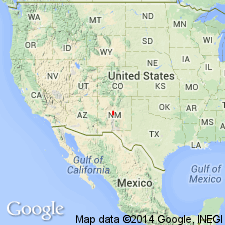
- Usage in publication:
-
- La Casa Member*
- Modifications:
-
- Original reference
- Dominant lithology:
-
- Siltstone
- Shale
- Calcarenite
- AAPG geologic province:
-
- Estancia basin
- San Juan basin
Summary:
Pg. F6-F7 (fig. 2, graphic stratigraphic columns), F10-F11. La Casa Member of Wild Cow Formation (new) of Madera Group. At type section consists of (descending): (1) a 30-foot-thick bed of light-olive-gray calcarenite at top; (2) a thin sequence of red and gray shale and yellowish-green calcareous sandstone, [about 40 feet thick]; (3) a ridge-forming light-gray calcarenite with some chert, [about 100 feet thick]; and (4) poorly exposed siltstone and shale, about 120 feet thick, at base. Total thickness about 290 feet. Is top member of Wild Cow Formation. Underlies Bursum Formation of Madera Group and overlies Pine Shadow Member (new). Previously called informal unit D of upper part of upper Madera Limestone. Fossils. Carries fusulinid TRITICITES sp. indicating middle to late Virgilian age; uppermost beds of member yielded fusulinids similar to, but not conspecific with, earliest Wolfcamp T. CREEKENSIS Thompson, 1954. Age of member is considered Late Pennsylvanian (middle to late Virgilian).
Type section [= type section of Wild Cow and Los Moyos Formations]: on west side of Priest Canyon in an east-draining ravine that cuts through a hogback, in sec. 7, T. 3 N., R. 5 E., [approx. Lat. 34 deg. 30 min. 03 sec. N., Long. 106 deg. 27 min. 48 sec. N., southern edge of Manzano Peak 7.5-min quadrangle], Manzano Mountains, Valencia Co., central NM.
Named from La Casa Spring, in SW/4 NE/4 sec. 6, T. 3 N., R. 5 E., [approx. Lat. 34 deg. 30 min. 54 sec. N., Long. 106 deg. 27 min. 28 sec. W., Manzano Peak 7.5-min quadrangle], Valencia Co., central NM.
[Typographical error (USGS geologic names lexicon, USGS Bull. 1520, p. 170): type section stated to be in Torrance Co., should be Valencia Co.]
Source: Publication; US geologic names lexicon (USGS Bull. 1520, p. 170)
- Usage in publication:
-
- La Casa Member*
- Modifications:
-
- Biostratigraphic dating
- AAPG geologic province:
-
- Estancia basin
- San Juan basin
Myers, D.A., 1988, Stratigraphic distribution of some fusulinids from the Wild Cow and Bursum Formations, Manzano Mountains, New Mexico: U.S. Geological Survey Professional Paper, 1446-B, p. 25-65.
Summary:
Pg. 31-33, pls. La Casa Member of Wild Cow Formation of Madera Group. At type section, in southern part of Manzano Mountains, consists of (ascending): (1) poorly exposed siltstone and shale at base, about 120 feet thick; (2) ridge-forming, light-gray calcarenite, about 100 feet thick; (3) red and gray shale and yellowish-green calcareous sandstone, about 40 feet thick; and (4) light-olive-gray calcarenite at top, about 30 feet thick. Total thickness about 290 feet. Northward, in the Tajique and Sol se Mete [Peak] areas, consists of (ascending): (1) arkosic and locally conglomeratic beds at base, about 30 to 50 feet thick; (2) alternating beds of limestone, siltstone, sandstone, and shale, [100 feet thick]; and (3) reds beds and a few thin beds of gray calcarenite at top, [30 feet thick]. Lies within the fusulinid Foraminifera zone of TRITICITES, assemblage subzones T. BEEDEI, T. WHETSTONENSIS, and T. CREEKENSIS, indicating Late Pennsylvanian to Early Permian (late Virgilian to Wolfcampian).
Source: Publication.
For more information, please contact Nancy Stamm, Geologic Names Committee Secretary.
Asterisk (*) indicates published by U.S. Geological Survey authors.
"No current usage" (†) implies that a name has been abandoned or has fallen into disuse. Former usage and, if known, replacement name given in parentheses ( ).
Slash (/) indicates name conflicts with nomenclatural guidelines (CSN, 1933; ACSN, 1961, 1970; NACSN, 1983, 2005, 2021). May be explained within brackets ([ ]).

